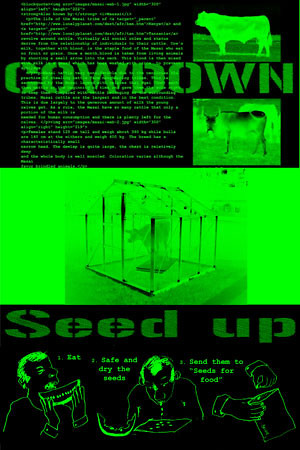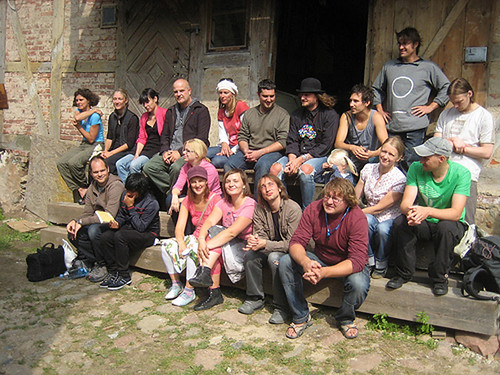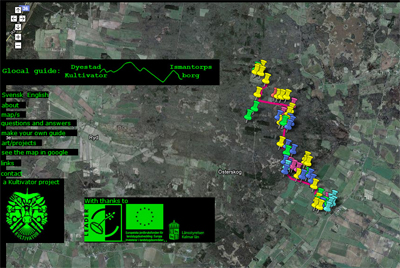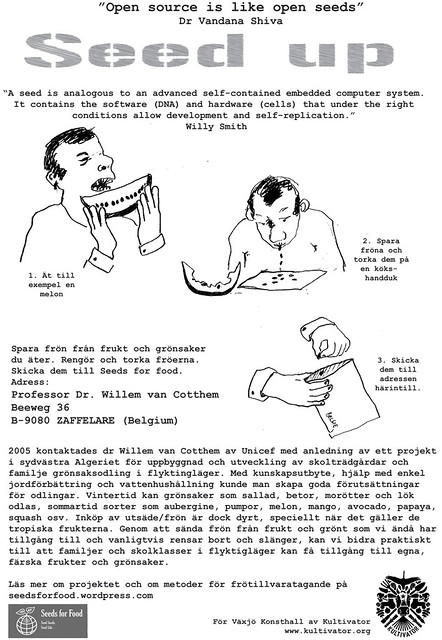
 . . . Organisers: RIXC, the Center for New Media Culture in cooperation with Association for Contemporary Culture NGOs (Latvia) and international partners.
. . . Organisers: RIXC, the Center for New Media Culture in cooperation with Association for Contemporary Culture NGOs (Latvia) and international partners.
More info
see the website
ABOUT ORGANIZED NETWORKS Training Programme for Cultural Network Management Riga, December 3 – 5, 2009 By addressing issues of cultural sustainability with focus on networking, the Training Programme for cultural network management entitled “Organized Networks” will take place in Riga, December 3 – 5, 2009, gathering together representatives from more then 20 cultural organisations, new media centers and networks from Baltic, Nordic and other European regions, as well as Caucasus countries. The Training Programme is co-organised by the RIXC, the Center for new media culture (Latvia) and partners from Finland (Pixelache festival, MARIN Association), Norway (Piksel, iolab, Atelier Nord), Iceland (Lorna), Sweden (Kultivator, C-Studio/Interactive Institute, New Media Meeting), Denmark (FieldWork, WindFestiva/Energy Academy), Lithuania (KCCC), Latvia (Association for Cultural NGOs), the Netherlands (Baltan Laboratories), Armenia (ACCEA/NPAK) and Georgia (Center for Contemporary Art – Tbilisi, GeoAir). . . . Conceptual background The current global crisis motivates us again to think of “how to remake the world” as many of methods used previously have turned out finite and unsustainable. New approach in terms of both – design and production today is urged nearly in all fields, including culture. The idea of “networks” is not new, but it contains potential that hasn’t been exploited to a great extent yet. New media networks have already more then ten years of experience. Translocal as well as local networking has played an important role in supporting operation of small-scale cultural organisations. However, networks as such are not only virtual structures, there are people and real technical infrastructures behind them, and our network culture also are facing the same sustainability issues. How to work out new strategies and methodologies for improving and developing more sustainable translocal cooperation practice (“organized networks”). And how to develop new network-based models for facilitating individual / local cultural organisations (“network nodes”)? An idea of “organized networks” (as proposed by Ned Rossiter, Geert Lovink) considers, if network can be seen as a new form of institution, and argues that it is relevant not only to work out new methodologies for networking practice – i.e. tools and protocols (agreed ways to support activity in the network), but also to discuss ‘collaborative value system’ (dealing with issues such as funding, internal power plays, and the demand of “accountability” and “transparency”, etc.). The Training Programme will investigate, what strategies “organized networks” can offer for sustainable development of cultural sector, and translocal cooperation in particular. The Training Programme will specifically focus on evaluating the cultural network practice of Baltic-Nordic-EU region. This will include NICE and Pixelache festival networks, Baltic-Nordic artists residency programmes, Nordic funding structure, future development of new media art centers, their local and translocal cooperation strategies, etc. The ways how networks can create and sustain their own infrastructure will also be discussed. Geographically, the Programme also aims to enhance European cultural area by drawing out new cultural cooperation axis connecting Nordic, Baltic and Caucasus regions on the Northern and Eastern border of Europe. With regard to the conceptual content, the Training Programme will explore the potential of emerging interdisciplinary cooperation among the fields of arts, science and sustainable (information and energy) technologies, in order to set up a common ground for developing Art and Renewable Energy Network and to discuss possible future co-projects. It also will be disucssed how artists, new media activists, renewable technology researchers, social software developers, open source activists, designers of autonomous and alternative infrastructures who already work together, deal with sustainability issues, discussing how may cultural organizations and their networks benefit from these artistic innovations for building their future sustainability. . . . . . . . . . . . . . . . . . . . . . . . . . . . . . . . . . . . . . . . . . . . . . . . . . . . . . . . . . . . . . . . . . . . . . . . . . Locations: Public lectures: Spīķeri, kim? building, 3rd floor, Maskavas iela 12/1, Riga (near Central Market). Training programme: RIXC Media Space, 11. Novembra krastmala 35, entrance from Minsterejas iela (in Old Town). . . . Organisers: RIXC, the Center for New Media Culture in cooperation with Association for Contemporary Culture NGOs (Latvia) and international partners. . . . Contact: rixc@rixc.lv tel. +371-26546776 (Rasa Smite) tel. +371-67228478 (RIXC office) . . . Support: European Culture Foundation, Nordic Culture Point, State Culture Capital Foundation, Hotel Elizabete.


At the harvestfeast of 2009 we were honoured with works of: Music and Art Centre “ Yellowbox” who made a living jukebox with singer songwriter John Leo Carter.
The artist Jonas Rahm,
The photographer Simon Johansson,
The artist Marlene Lindmark
and the philosopher Jonas Gren.
Besides this we showed works of Kultivator
and sold vegetables from the farm.
[AFG_gallery id=’21’]

 For European union agricultural minister meeting in Växjö, Sweden
For European union agricultural minister meeting in Växjö, Sweden
invitation by Växjö arthall
Seed up !
Is a campaign to support the Belgian project seeds for food, initiated by prof. Willem van Cotthem. The project objective is to collect seeds for growers in North african refugeecamps. Just the seeds from tropical fruit and vegetables that we have an abundance of in our supermarkets and on our kitchentables, are expensive and hard to get hold on for people cultivating in the areas where they climatwise easily can be grown. Seeds are by nature hardy and if we collect them from our food, dry them and pack them with some care, they can be used and provide food for people in camps that have very little access to fresh food otherwise. The very grassroot, user friendly character of the action, is also suggesting an alternative to great scale aid projects, and great scale agriculture policies (=monopoly), letting information and seeds travel independently over unionborders
Cowdown !
Kultivator shows two pieces, that concerns the development towards less biodiversity and injust distribution of foods and goods globally, promoted a.o. by European union Common Agricultural Policy (CAP). In both works the link is laid between the restriction on freedom and development that monopoly and closedcode/copyright is causing in software and the same phenomena occurring on farming and food supply.
The Cowdown is an installation with a reconstruction of a now extinct breed of cow, ”The Ölandsko” that used to be common on the island where Kultivator is sited. The cow is modelled 1:1, and standing inside a small ready made greenhouse outside Växjö public library. Inside the library, visible from outside, is a screen with the cowdown terminal animation, showing source code and a large variety of cattle breeds from all over the world. Images of the various breeds and short facts about their characteristics, history and breeding schemes are colored in the terminal green black, suggesting that we are watching a wonderful richness of variety, that needs to be kept, and at best expanded.
Seedup poster, cowdown film
[AFG_gallery id=’20’]



Symposium is organised by RIXC, The center for new media culture with the support of Nordic Culture Fund, and Nordic Culture Point
ABOUT SYMPOSIUM
The 4-day symposium gathering together artists, activists, technologists, scientists and researchers, to share their ideas and explorations which deal with renewable energy resources, alternative ecological use of technologies, and other sustainability related issues.
Themes:
[bio / eco]
Environmental science and ecology – Ecosystem research – Permaculture and biosystem design – Biomass as renewable energy resource – Critical and alternative approaches to biotechnology
[solar energy]
Sunlight as constant energy resource – Process of photosynthesis – Solar energy technologies
[open source]
Sustainability using open source/information approaches: in art and grassroots culture, ecology, architecture and environmental design
[myths & legends]
Historical traditions and modern alternative solutions – Cultural transformations: energy in nature and in city – Future visions of terrestrial energy
Location:
The symposium will take place in artists residency center SERDE in Aizpute, a small town in Kurzeme region of Latvia. SERDE is located in old wooden historical building that also will be used as a specific case for which alternative and ecological approach in developing sustainable systems and renewable energy technologies can be explored and applied.
http://www.serde.lv
The outcomes of the symposium – new projects, artworks, co-productions – will be presented during the international art and science conference ENERGY that will take place in the framework of Art+Communication festival in Riga, October 8-10, 2009. (The call for proposals for ENERGY festival and conference is currently open: deadline August 31, 2009. http://rixc.lv/09)
see: http://renewable.rixc.lv/?page_id=2

 Info
Info
Go to Glocal guide website
See the map
Glocal guide is an ongoing Kultivator project.
Sustainability using open source / information approaches: in art and grassroots culture, ecology, architecture and environmental design
Sustainability using Open source approaches on eco tourism and local community awareness.
Linking The right of public access to nature (part of the swedish constitution, giving rights to anyone to roam the wild) with the rights and possibilities of public access to information and history.
We present our recent Project ”Glocalguide”, that links contemporary open source structures for information sharing to an ancient common walking path.
From the village commonland, next to Kultivators ground, leads a path through the forest to an ancient ruin fortress, dated to somewhere around 200 b.c.
The path has historically been used for bringing cattle out to graze in the forest, and for people from now abandoned villages in the forest to go to school, church or the market. Much of the flora and fauna along the path is rare and unique for swedish nature, due to the long history of use by man and grazing animals. The fortress ruin the path leads to, has never been fully excaveted and no all over accepted explanation over its function exists, leaving plenty of room for popular beliefs and tales over.
Information and knowledge about the flora and fauna, historical facts and speculations are highly interesting and plentiful, but hard to get hold on for a visitor, or the younger generation living here.
The project intended to set a structure, both analogue and digital, for sharing this information, and build on an open source guide for this specific route, that will be owned by everybody and nobody, mimmicking the common use of as well the forest as of the path with communal respect and cooperation. In our presentation we will give a short resume over this work, and show examples of the strategies we have used to engage different cathegories of people to contribute.
[AFG_gallery id=’19’]
Glocal guide is an ongoing Kultivator project. Sustainability using open source / information approaches: in art and grassroots culture, ecology, architecture and environmental design Sustainability using Open source approaches on eco tourism and local community awareness. Linking The right of public access to nature (part of the swedish constitution, giving rights to anyone to roam the wild) with the rights and possibilities of public access to information and history. We present our recent Project ”Glocalguide”, that links contemporary open source structures for information sharing to an ancient common walking path. From the village commonland, next to Kultivators ground, leads a path through the forest to an ancient ruin fortress, dated to somewhere around 200 b.c. The path has historically been used for bringing cattle out to graze in the forest, and for people from now abandoned villages in the forest to go to school, church or the market. Much of the flora and fauna along the path is rare and unique for swedish nature, due to the long history of use by man and grazing animals. The fortress ruin the path leads to, has never been fully excaveted and no all over accepted explanation over its function exists, leaving plenty of room for popular beliefs and tales over. Information and knowledge about the flora and fauna, historical facts and speculations are highly interesting and plentiful, but hard to get hold on for a visitor, or the younger generation living here. The project intended to set a structure, both analogue and digital, for sharing this information, and build on an open source guide for this specific route, that will be owned by everybody and nobody, mimmicking the common use of as well the forest as of the path with communal respect and cooperation. In our presentation we will give a short resume over this work, and show examples of the strategies we have used to engage different cathegories of people to contribute.

 . . . Organisers: RIXC, the Center for New Media Culture in cooperation with Association for Contemporary Culture NGOs (Latvia) and international partners.
. . . Organisers: RIXC, the Center for New Media Culture in cooperation with Association for Contemporary Culture NGOs (Latvia) and international partners.





